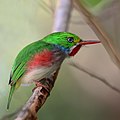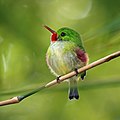Superregnum: Eukaryota
Cladus: Unikonta
Cladus: Opisthokonta
Cladus: Holozoa
Regnum: Animalia
Subregnum: Eumetazoa
Cladus: Bilateria
Cladus: Nephrozoa
Superphylum: Deuterostomia
Phylum: Chordata
Subphylum: Vertebrata
Infraphylum: Gnathostomata
Megaclassis: Osteichthyes
Cladus: Sarcopterygii
Cladus: Rhipidistia
Cladus: Tetrapodomorpha
Cladus: Eotetrapodiformes
Cladus: Elpistostegalia
Superclassis: Tetrapoda
Cladus: Reptiliomorpha
Cladus: Amniota
Classis: Reptilia
Cladus: Eureptilia
Cladus: Romeriida
Subclassis: Diapsida
Cladus: Sauria
Infraclassis: Archosauromorpha
Cladus: Crurotarsi
Divisio: Archosauria
Cladus: Avemetatarsalia
Cladus: Ornithodira
Subtaxon: Dinosauromorpha
Cladus: Dinosauriformes
Cladus: Dracohors
Cladus: Dinosauria
Ordo: Saurischia
Cladus: Eusaurischia
Cladus: Theropoda
Cladus: Neotheropoda
Cladus: Averostra
Cladus: Tetanurae
Cladus: Avetheropoda
Cladus: Coelurosauria
Cladus: Tyrannoraptora
Cladus: Maniraptoromorpha
Cladus: Maniraptoriformes
Cladus: Maniraptora
Cladus: Pennaraptora
Cladus: Paraves
Cladus: Eumaniraptora
Cladus: Avialae
Infraclassis: Aves
Cladus: Euavialae
Cladus: Avebrevicauda
Cladus: Pygostylia
Cladus: Ornithothoraces
Cladus: Ornithuromorpha
Cladus: Carinatae
Parvclassis: Neornithes
Cohors: Neognathae
Cladus: Neoaves
Ordo: Coraciiformes
Familia: Todidae
Genus: Todus
Species: T. angustirostris - T. mexicanus - T. multicolor - T. subulatus - T. todus
Name
Todus Brisson, 1760
Typus
Alcedo todus Linnaeus, 1758 = Todus todus
References
Brisson, M.J. 1760. Ornithologie ou méthode contenant la division des oiseaux en ordres, sections, genres, especes & leurs variétés. A laquelle on a joint une description exacte de chaque espece, avec les citations des auteurs qui en ont traité, les noms qu'ils leur ont donnés, ceux que leur ont donnés les différentes nations, & les noms vulgaires. Ouvrage enrichi de figures en taille-douce. Tome I. - pp. j-xxiv [= 1-24], 1-526, j-lxxiij [= 1-73], Pl. I-XXXVII [= 1-37]. Paris. (Bauche). Original description p.44 BHL Reference page. Tome 4 p.528 BHL Illustration pl.XLI, fig.2 BHL
Vernacular names
dansk: Todier
Deutsch: Todis
English: Todies
magyar: Todifélék
Nederlands: Todies
polski: Płaskodziobki
Türkçe: Todi
Todus is a genus of birds in the family Todidae, the todies, found in the Caribbean. It is the only extant genus within the family Todidae. The five species are small, near passerine birds of the forests of the Greater Antilles: Puerto Rico, Jamaica, and Cuba, with adjacent islands, have one species each, and Hispaniola has two, the broad-billed tody in the lowlands (including Gonâve Island) and the narrow-billed tody in the highlands.[1][2]
Taxonomy and systematics
The genus Todus was introduced by the French zoologist Mathurin Jacques Brisson in 1760 with the Jamaican tody (Todus todus) as the type species.[3][4] Todus is a Latin word for a small bird mentioned by the Roman playwright Plautus and the grammarian Sextus Pompeius Festus.[5] This name had earlier been used for the Jamaican tody by the Irish physician Patrick Browne in his book The Civil and Natural History of Jamaica which was published in 1756.[6]
Extant species
Five species are recognized:[7]
| Image | Scientific name | Common Name | Distribution |
|---|---|---|---|
 |
Todus multicolor | Cuban tody | Cuba |
 |
Todus subulatus | Broad-billed tody | Hispaniola |
 |
Todus angustirostris | Narrow-billed tody | Haiti and the Dominican Republic. |
 |
Todus todus | Jamaican tody | Jamaica |
 |
Todus mexicanus | Puerto Rican tody | Puerto Rico |
Former species
Emperor fairywren (as Todus cyanocephalus)[8]
Leaden flycatcher (as Todus rubecula)[9]
Description
Todies range in weight from 5 to 7 g and in length from 10 to 11.5 cm. They have colourful plumage and resemble kingfishers in their general shape. They have green heads, backs and wings, red throats (absent in immature Puerto Rican, broad-billed, and narrow-billed Todies[1]) with a white and blue-grey stripe on each side, and yellow undertail coverts; the colour of the rest of the undersides is pale and varies according to species. The irises are pale grey. They have long, flattened bills (as do many flycatching birds) with serrated edges; the upper mandible is black and the lower is red with a little black. The legs, and especially the feet, are small.[2] Todies are highly vocal, except that the Jamaican tody seldom calls in the non-breeding season (August to November);[1] they give simple, unmusical buzzing notes, beeps, and guttural rattles, puffing their throats out with every call.[2] Their wings produce a "strange, whirring rattle", though mostly when courting or defending territory in the Puerto Rican tody.[1]
Behaviour and ecology
Todies are generally sedentary; the longest single flight known for the broad-billed tody is 40 m.[1][2] Their activity is greatest in the morning when sunny weather follows rain, and in March and September.[1]
Breeding
Like most of the Coraciiformes, todies nest in tunnels, which they dig with their beaks and feet in steep banks[2] or rotten tree trunks.[1] The tunnel is 30 cm long in the Cuban and narrow-billed Todies, 30 to 60 cm in the broad-billed tody,[1] and ends in a nest chamber, generally not reused. They lay about four round white eggs in the chamber. Both parents incubate but are surprisingly inattentive to the eggs. The young are altricial and stay in the nest until they can fly. Both parents also care for the nestlings, much more attentively; they may feed each chick up to 140 times per day, the highest rate known among birds.[2]
Food and feeding
Todies eat small prey such as insects and lizards. Insects, particularly grasshoppers, crickets, beetles, bugs, butterflies, bees, wasps, and ants, form the greater part of the diet. Spiders and millipedes may also be taken, as is a small amount of fruit (2% of the diet).[10] Todies typically sit on a low, small branch, singly or in pairs, keeping still or stepping or hopping sideways. When they see prey moving on the lower surface of a leaf, they fly a short distance (averaging 2.2 m in the broad-billed tody and 1.0 m in the Puerto Rican tody[1]), diagonally upward to glean it. They may also take prey from the ground, occasionally chasing it with a few hops.
References
Raffaele, Herbert; James Wiley; Orlando H. Garrido; Allan Keith; Janis I. Raffaele (1998). A Guide to the Birds of the West Indies. Princeton University Press. pp. 341–343. ISBN 0-691-08736-9. Retrieved 2008-07-02.
Fry, C. Hilary (2003). "Todies". In Perrins, Christopher (ed.). Firefly Encyclopedia of Birds. Firefly Books. pp. 373. ISBN 1-55297-777-3.
Brisson, Mathurin Jacques (1760). Ornithologie, ou, Méthode Contenant la Division des Oiseaux en Ordres, Sections, Genres, Especes & leurs Variétés (in French and Latin). Paris: Jean-Baptiste Bauche. Vol. 1, p. 44, Vol. 4, p. 528.
Peters, James Lee, ed. (1945). Check-list of Birds of the World. Vol. 5. Cambridge, Massachusetts: Harvard University Press. p. 220.
Jobling, James A. (2010). The Helm Dictionary of Scientific Bird Names. London: Christopher Helm. p. 387. ISBN 978-1-4081-2501-4.
Browne, Patrick (1756). The Civil and Natural History of Jamaica. London: Printed for the author, and sold by T. Osborne and J. Shipton. p. 476.
"IOC World Bird List 6.4". IOC World Bird List Datasets. doi:10.14344/ioc.ml.6.4.
"Malurus cyanocephalus (Emperor Fairywren) - Avibase". avibase.bsc-eoc.org. Retrieved 2017-11-16.
"Myiagra rubecula - Avibase". avibase.bsc-eoc.org. Retrieved 2017-01-24.
Kepler, A. K. (2001). "Family Todidae (Todies)". In J. del Hoyo; A. Elliott; J. Sargatal (eds.). Handbook of the Birds of the World. Volume 6, Mousebirds to Hornbills. Barcelona: Lynx Edicions. ISBN 84-87334-30-X.
Retrieved from "http://en.wikipedia.org/"
All text is available under the terms of the GNU Free Documentation License

